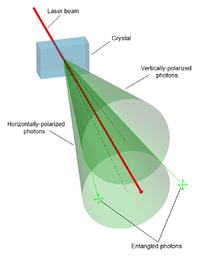
Photo from wikipedia
The security of quantum cryptography protocols after a quantum key distribution (QKD) session is formulated in terms of proximity between two situations: quantum states corresponding to real and ideal situations… Click to show full abstract
The security of quantum cryptography protocols after a quantum key distribution (QKD) session is formulated in terms of proximity between two situations: quantum states corresponding to real and ideal situations after QKD. The measure of proximity is the trace distance. It is more reasonable to formulate security directly in terms of the smallness of probability of successive guessing of keys by an eavesdropper after an arbitrary number of QKD sessions. There is a fundamental question the answer to which is a priori very unobvious: Is the security criterion in terms of the proximity of the real and ideal situations for a single QKD session sufficient to guarantee the security of keys in terms of the smallness of probability of guessing of keys by the eavesdropper after an arbitrary number of QKD sessions? It has been shown that the answer to this question is positive.
Journal Title: JETP Letters
Year Published: 2017
Link to full text (if available)
Share on Social Media: Sign Up to like & get
recommendations!